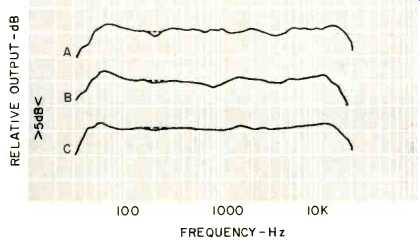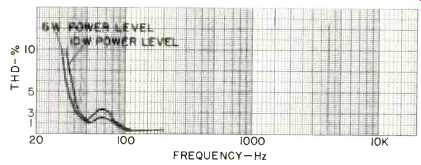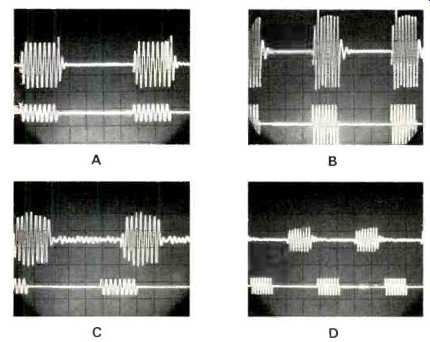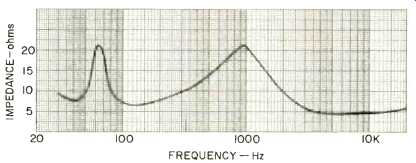
MANUFACTURER'S SPECIFICATIONS
System Type: Two way.
Components: 10 in. bass speaker, 2 in. treble.
Frequency Response: 40 to 18,000 ±5 dB.
Nominal Impedance: 8 ohms.
Dimensions: 14 1/2 H by 25 1/2 W by 11 1/2 D.
Price: $129.00.
The Marantz Imperial 6 is a new two-way system using a 10 in. bass unit with a 2 in. cone tweeter. This latter is fitted with a hard dome at the center to smooth the response and obtain a wide dispersion. A heavy paper cone is used in the bass speaker, and the surround is a plasticized cloth. The voice coil is unusually large at 2 in., and the magnet structure weighs 2 lbs. Crossover is about 3000 Hz (an octave above the tweeter resonance point), and a three-position switch gives a choice of lift or cut. Instead of the usual acoustic suspension or infinite baffle arrangement, the 6 uses a tuned port and the enclosure itself is filled with fiberglass.
The cabinet is finished in walnut with a black trim and appears to be solidly constructed. The grille cloth is brown and the front is held on by plastic foam pads.

Fig. 1--Response curves with one-third octave pink noise; A is taken on-axis,
B at 45 degrees off-axis, and C is an average of five angles.
Figure 1 shows the response curves using one-third octave pink noise; A is taken on-axis, B at 45 degrees, and C is an average of the response at five angles. All were measured with the treble control in the center or normal position. Response below 200 Hz will be affected by room conditions, and a corner position will, of course, increase the low frequency output. The small dip at 200 Hz is due to phase-cancellation and should be disregarded. Figure 2 shows the frequency response with the treble switch in its three positions and it will be seen that each step has a one dB change.
At 7 watts input, frequency doubling commenced at 42 Hz but a useful output was obtained down to 35 Hz. Figure 3 shows the harmonic distortion at 5 and 10 watt levels.
Transient response was particularly good at low frequencies, as can be seen from the tone-burst photographs in Fig. 4.
The impedance curve showed a low point of 4.5 ohms, rising to a maximum of 22.5--typical of two-way systems. System resonance was approximately 60 Hz. White noise tests confirmed the smooth overall response and coloration was quite small. Sensitivity was somewhat above average; quoted efficiency is 95 dB SPL from one watt input at 400 Hz. An amplifier with 15 to 25 watt rms per channel capacity would be sufficient for most people when used with Imperial 6 speakers in a medium-sized room.

Fig. 2--Frequency response with the tweeter level control in three positions.

Fig. 3--Harmonic distortion at low frequencies

Fig. 4--Tone-burst response at A, 50, B, 100 C, 3000, and D, 10,000 Hz.

Fig. 5-Impedance characteristics.
Listening Tests
The first impression was of a better-than-average transient response and a clean bass with a commendable freedom from coloration-especially in the 80 to 200 Hz region, which can give that voice-in-a-barrel effect. Extended listening tests over a period of three weeks confirmed these opinions. The center or normal position of the treble control was found to be the best for my room unless the speakers were angled inwards when the highest position was preferred.
Summing up:
The Marantz 6 can be recommended to those who require a bookshelf system with above average performance.
-T.A.
(Audio magazine, Apr. 1972)
Also see:
Marantz speaker system (ad, Apr. 1973)
Marantz 940 speaker system (May 1978)
= = = =